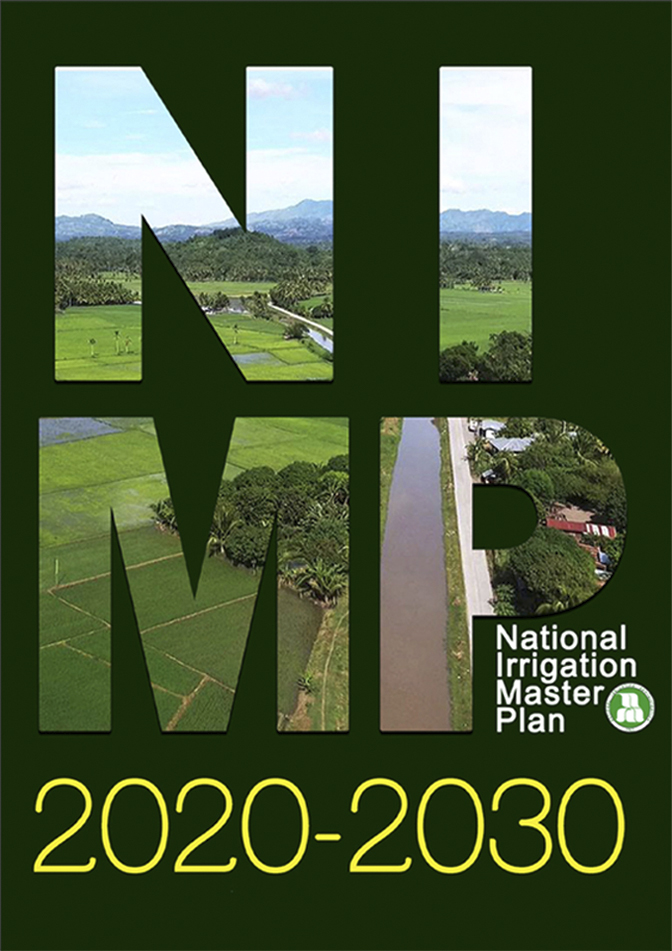UPLBFI develops 10-year National Irrigation Master Plan
November 24, 2021LOS BAÑOS, LAGUNA – In response to the need for national guidelines for irrigation development in the Philippines, the UPLB Foundation Inc. (UPLBFI) was commissioned by the National Irrigation Administration (NIA) and National Economic and Development Authority (NEDA) in formulating the National Irrigation Master Plan (NIMP) for the period 2020-2030.
The NIMP 2020-2030 is an updated and enhanced version of the 2017-2026 Master Plan crafted by NIA. A holistic and comprehensive approach was espoused in updating, enhancing, and improving the master plan. This entailed consideration of not only engineering and technical aspects but also economic, social, environmental, organizational, institutional, financial, and legal dimensions.
The NIMP 2020-2030 is also consistent with the Philippine Development Plan (PDP) for 2017–2022. In the PDP, one of the infrastructure strategies for water resources programs is “to formulate a master plan to set the direction for irrigation development and a framework for capital, and operation and maintenance financing of irrigation projects.”
Contents of the NIMP 2020-2030
The complete NIMP 2020–2030 is a comprehensive, integrated, robust, collaborative, and scientifically-based blueprint towards accelerated and sustained irrigation development in the Philippines.
The Master Plan opens with a report of the status of and emerging issues in the country’s irrigated agriculture sector. This section paints a picture of the Philippines’ state of land resources, water resources, socio-economic conditions, agricultural productivity and farmers’ income, irrigation development, and institutional development. Emerging issues and constraints in irrigation development, such as the Free Irrigation Service Act (FISA) was also considered.
The NIMP 2020-2030 also presented a thorough review of the of the 2017-2026 Master Plan from its objectives to its budgetary requirements. This review leads to a discussion of the methodology employed in formulating and updating the NIMP 2020–2030. The lion’s share of this document is the master plan proper, covering crucial components, such as its objectives, results framework, implementation framework, physical targets, outputs, projected costs and benefits, and monitoring and evaluation plan.
Finally, the NIMP 2020-2030 closes with a series of recommendations for its effective implementation.
Major objective and outputs of the NIMP 2020-2030
The general objective of the NIMP 2020-2030 is to achieve food security and poverty reduction with accelerated and sustained irrigation development under diversified crop production systems.
To attain this goal, NIMP 2020-2030 presented the following outputs vis-à-vis its specific objectives: (1) developed a new geodatabase system and generate updated geospatial data including updated estimates of potential irrigable areas, irrigation water supply and demand, and other relevant irrigation system planning and design parameters (2) formulated performance targets and indicators consistent with the PDP Results Matrix (3) formulated physical targets for irrigation development, taking into account DA’s Rice Roadmap and Rice Tarrification Act (RTA) (4) developed an investment program of projects for the medium- and long-term, including readily implementable new projects in the short term (5) provided guidelines for the development of a maintenance enhancement and operation plan of irrigation systems, including strategies on asset management, and taking into consideration the Free Irrigation Service Act (FISA) (6) provided ways and options on how to integrate emerging water-efficient technologies, and Climate Change Adaptation (CCA)/Disaster Risk Reduction and Management (DRRM) in irrigation development (7) provided irrigation options for crop diversification in realigning irrigation development to support diversified agricultural production systems, and lastly, (8) Developed “The NIA Strategic Plan 2020-2030” as a guide for its institutional reforms for an efficient and successful new Master Plan.
The Project Team
The project team was led by Dr. Victor B. Ella (Project Leader) together with other technical experts, research associates and managed by its project management team in close coordination with NEDA and NIA and other relevant stakeholders (LGUs, NGAs, other development partners, etc.).
Water Resources Component
Dr. Victor B. Ella – Water Resources Development Planning Specialist cum Team Leader
Dr. Rubenito M. Lampayan – Irrigation Engineer
Dr. Roger A. Luyun, Jr. – Water Resources Engineer
Engr. Ginalyn Robel M. Brazil – Research Associate
Engr. Kareen B. Garcia – Research Associate
Engr. Jay Ann Q. Lomod – Research Associate
Engr. Isabel Katrina Cajuguiran – Research Associate
Engr. Marie Aislin Cabriole – Research Associate
GIS Component
Dr. Nathaniel C. Bantayan – GIS Specialist
Dr. Cristino L. Tiburan, Jr. – GIS Specialist
Mr. Ralphael P. Gonzales, EnP – Research Associate
For. Carl Earvin D. Carada – Research Associate
For. Ida Kristine M. De Guia – Research Associate
Financial Component
Dr. Agham C. Cuevas – Financial Specialist
Dr. Arlene B. Inocencio – Agricultural Economist
Mr. Arvin Jay S. Carandang – Research Associate
Mr. Arman Baulita – Research Associate
Organizational Component
Dr. Eliseo R. Ponce (†) – Organizational Development Specialist
Ms. Abegail V. Gillado – Research Associate
Mr. Alexis Baulita – Research Associate
Environmental and Social Components
Dr. Tolentino B. Moya – Environmental Specialist
Dr. Felixberto H. Roquia, Jr.(†) – Social Specialist
Mr. Jonathan DC. Austria – Research Associate
Project Management Unit
Ms. Dorcas V. Trinidad – Project Management Specialist
Ms. Julie Ann U. Barril – Project Documentation Specialist
Ms. Pattricia Eliz M. Legaspi – Research Associate
Mr. Roi Louis F. Mojado – Research Associate
Information, Education and Communication
Mr. Aldo Gavril T. Lim – IEC Specialist
Ms. Sarena Grace Quinones – Design and Layout Artist(Abridged and Primer)
The project commenced in September 2018 and concluded in December 2020.
by Julie Ann Barril

